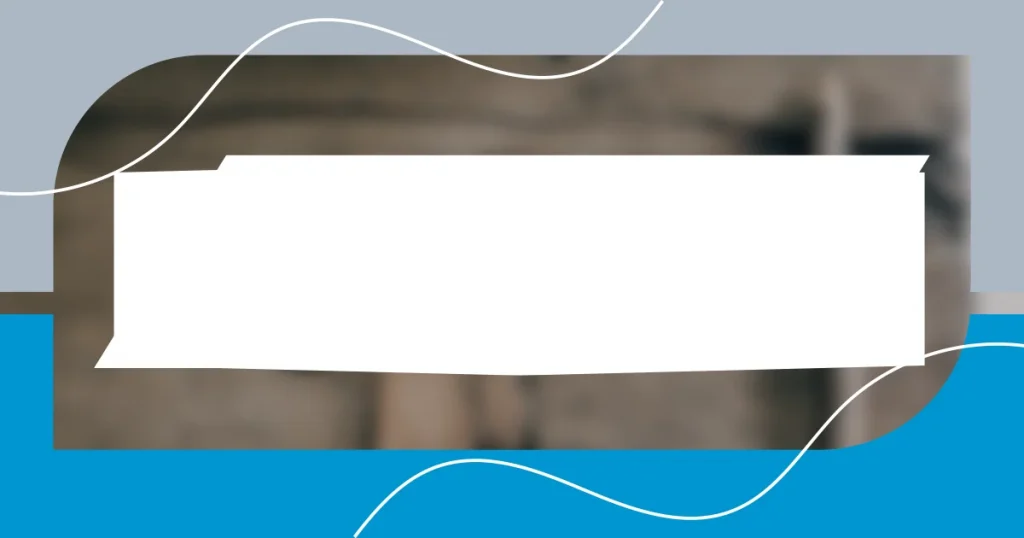Key takeaways:
- Understanding wood finishing techniques involves knowing both the wood type and the finishes, as each choice impacts the final appearance and durability.
- Proper surface preparation, including sanding with the correct grit and cleaning, is essential for achieving a vibrant and lasting finish.
- Evaluating and troubleshooting imperfections is crucial; always inspect finishes under good lighting, and employ creative solutions for fixing flaws.

Understanding wood finishing techniques
When I first delved into wood finishing techniques, I was amazed at how each method could drastically change the look and feel of the wood. I remember standing in my workshop, feeling the grain of a freshly sanded oak piece, pondering how different stains could either highlight or obscure its natural beauty. It struck me then: choosing the right finish is as much an art as it is a science, each option offering a unique character and emotional resonance.
One of the most enlightening moments in my wood finishing journey came when I experimented with different finishes on a single item—a simple coffee table. After applying an oil finish, the warmth and depth of the wood made my heart race. Yet, with polyurethane, the surface glistened in a way that made me see it as something completely different. Have you ever had an experience where a single choice transformed the way you felt about a project?
I’ve come to realize that understanding wood finishing techniques isn’t just about the finishes themselves, but also about knowing the wood. For instance, certain finishes work better on softwoods versus hardwoods, which can influence the outcome significantly. Every time I mix my stains or select my sealers, I’m reminded of the delicate balance between enhancing the wood’s natural beauty and protecting it for years to come. Isn’t it fascinating how this blend of choice and technique impacts not just the furniture, but also the stories they hold?

Selecting the right wood type
Selecting the right wood type is crucial for achieving that perfect finish. Each type of wood brings its own personality, influencing not only the final appearance but also the texture and durability. I still remember my first project—a walnut shelf. The rich, dark hues complemented the stain beautifully, but had I chosen a more porous wood like pine, I would have faced a completely different challenge in achieving that depth of color.
Here are some key considerations when selecting the right wood type:
- Grain Pattern: Different woods exhibit unique grain patterns, which can enhance or detract from the finish.
- Porosity: Woods like birch absorb finishes differently than hardwoods, affecting the final look.
- Color Base: The inherent color of the wood can influence how stains and finishes appear. For example, maple will reflect colors differently than cherry.
- Durability: Consider the usage; softer woods may not hold up as well in high-traffic areas.
- Personal Preference: Don’t underestimate the emotional connection. Picking a wood that resonates with you can enhance your project’s personal significance.
Reflecting on my own journey with wood types has shaped not only my projects but also my appreciation for the intricate dance of grain and finish. Each selection tells a story, and I find joy in every layer I add.

Preparing wood surface properly
Preparing the wood surface properly is a pivotal step in achieving that perfect finish. I’ve learned through trial and error that the smoother the surface, the better the finish adheres and the more vibrant the final appearance. For instance, I once hurried through sanding a beautiful cherry wood tabletop, thinking it would save time. The result? A patchy finish that haunted me every time I walked past it. Taking the time to sand adequately can feel tedious, but it pays off immensely.
Different grit sizes matter as well. Starting with a coarser grit removes imperfections quickly, while finishing with a fine grit brings out a buttery smoothness. Just recently, I switched from using 120-grit to 220-grit for my final passes, and the difference in texture was astounding. The finish glided on like a dream, enhancing every nuance of the wood grain. In your experience, what grit sizes have you found most effective in your projects?
It’s also essential to clean the surface after sanding. Dust and debris can disrupt the integrity of your finish. I made it a habit to wipe down surfaces with a tack cloth or a slightly damp microfiber cloth before applying my finish. This simple step has drastically improved the clarity and adherence of my final coatings. It’s funny how I once viewed cleaning as an afterthought, yet now I see it as a vital ingredient to a successful project.
| Step | Description |
|---|---|
| Sanding | Start with coarse grit (120) to remove imperfections, then progress to fine grit (220) for smoothness. |
| Cleaning | Use a tack cloth or damp microfiber cloth to remove dust and debris before finishing. |

Choosing finishes and tools
Choosing the right finish and tools can feel overwhelming, but I’ve found that clarity comes with experience. For instance, when I first started, I stuck to varnishes because I feared the unknowns of oils and lacquers. However, after experimenting with Danish oil on a small side table, I discovered how it penetrated the wood, enhancing its natural beauty while providing a rich, warm glow. Have you ever hesitated to try a finish because of fear? I encourage you to explore—it might lead to unexpected rewards.
When it comes to tools, I’ve learned not all brushes are created equal. I remember a time when I opted for the cheapest brush at the hardware store, thinking it would do the job. The result was a streaky mess that left me frustrated and disheartened. Now, I swear by natural bristle brushes for oil-based finishes and foam applicators for polyurethane. Investing a little more in quality tools can save you hours of touch-ups and heartbreak, and the satisfaction of a flawless finish is well worth it.
I also think about the environment I work in. Lighting plays a significant role in how finishes appear. For example, under too dim a light, I couldn’t see the spots I’d missed during application, resulting in a patchy look that haunted me for weeks. I’ve taken to finishing in natural light whenever possible—it helps me catch those pesky imperfections before they become familiar adversaries. Have you considered how your workspace affects your finishing results? Adjusting your environment can make all the difference in the world.

Applying finish with precision
When it comes to applying finish with precision, I’ve found that patience truly is a virtue. I remember one project where I decided to apply a stain and a top coat in one go, thinking I could multitask my way to efficiency. It turned out to be a disaster—uneven patches and drips left me feeling defeated. Now, I take the time to allow the stain to dry properly before applying any top coat, ensuring that each layer has time to settle and adhere correctly. Have you ever rushed through a step only to regret it later?
The technique of application has also made a considerable difference in my results. A few years ago, I experimented with different methods, from brushes to rags, and I found that using a high-quality brush with long, gentle strokes created the most even finish. I remember watching a woodworking video where the instructor emphasized the importance of maintaining a wet edge. This approach prevents lap marks—those frustrating lines that can ruin an otherwise perfect job. Have you noticed how a simple tweak in your application technique can elevate your outcome?
Lastly, the climate you’re working in can impact drying times and finish quality. I once attempted a project during a humid summer and was met with a sticky situation—my finish refused to dry and left me with a tacky mess. Now, I always check the weather before I start. If it’s too humid, I wait for a drier day or use a dehumidifier. It’s a small consideration, but it’s saved me from countless aggravations and has led to smoother finishes. Have you ever felt the changing weather mess with your woodworking plans?

Sanding and polishing for perfection
Sanding is an essential step that I’ve learned to embrace over time. Initially, I saw it as a chore—something to get through before the fun part of finishing. However, there was a project where I skipped this step, thinking a quick once-over would suffice. The final product had an uneven surface that drove me nuts. Now, I spend ample time sanding at various grits, starting with a coarser grit and working my way down to a finer one. Each pass reveals a smoother surface that truly elevates the finish. Have you ever underestimated the importance of a good sanding?
Polishing is where the magic truly happens, and I’ve discovered it can transform an already nice finish into something spectacular. I remember a time when I polished a dining table using a soft cloth and a bit of elbow grease, not expecting much change. To my surprise, the richness of the wood came alive as the polish brought out the intricate grain patterns. It’s those little moments that remind me that finishing isn’t just a process; it’s an art. What have you done to make your projects shine?
Each layer of polish adds depth, but timing can make or break your efforts. I once polished a piece too soon, thinking it would give me a head start. Instead, I ended up with a dull finish that I had to redo, costing me time and materials. Now, I wait until the finish is fully cured—often a full week—before adding that luscious polish. It’s a small sacrifice for long-lasting beauty. Have you ever jumped the gun and regretted it? Enjoying the journey often means being patient.

Evaluating and troubleshooting imperfections
Evaluating imperfections in a wood finish can sometimes feel disheartening, especially after investing so much time and effort. There was a moment during a large project where I stepped back to admire my work, only to realize there were unsightly bumps in the finish. I remember feeling a wave of disappointment wash over me, but it was a learning moment. Now, I’ve made it a habit to inspect my finishes under good lighting before calling a project complete, which helps me spot flaws I might have missed otherwise.
Troubleshooting these imperfections often involves some detective work. On one occasion, I noticed a patch of discoloration on a beautifully stained tabletop. After some investigation, I discovered that I hadn’t mixed the stain well enough before application. It wasn’t just about fixing the surface; it was about understanding the root cause. I’ve since learned to always stir my finishes thoroughly and do a test spot when experimenting with new stains. Have you ever encountered a flaw that you thought was irreversible, only to find a fix?
Sometimes, the solution to an imperfection is simpler than you think. A while back, I found myself staring at a heavily streaked varnish finish that left me scratching my head. Instead of sanding it off—an often-tedious task—I quickly grabbed a clean, damp cloth and a bit of mineral spirits. I gently wiped the surface, and to my surprise, the streaks disappeared like magic. It taught me that approaching problems with a creative mindset can lead to surprising solutions. Have you ever resolved a frustrating flaw with an unexpected trick?
















